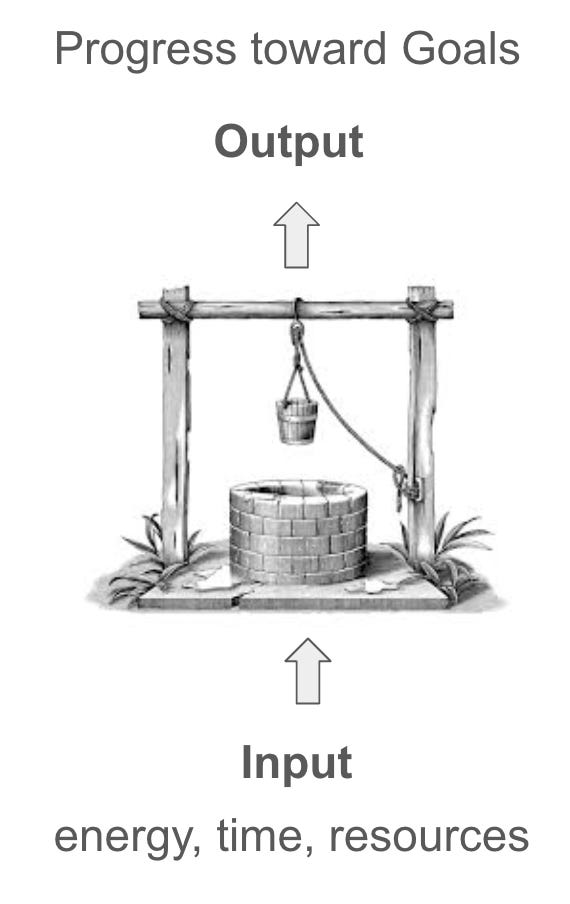My mother taught me that if you are sad, you should do the dishes. That way you are sad with clean dishes, which clearly beats being sad with dirty dishes. Clean dishes don’t solve sadness, but the ability to work and make progress in the world can eventually solve most things if they are solvable at all.
Over time I think I got pretty good at “doing the dishes” if doing the dishes means frisbeeing the china up a mountain with the pure determination and glee of a love baby between Goku and Sisapheus. I even taught a workshop about it. It had less flinging china and more jokes and advice. People liked it well enough, I figured it was worth putting down some words about it.
Doing Things Well
When I talk about productivity, I’m talking about the ratio of output per input. Thus your productivity is like your speed of travel toward your goals.

“Put” means “well” in Dutch, my native language, so all I think about with productivity is that you need to get more out of the well than you put in. And if you do well, you are productive.
Now to gain speed, you need to rev your engine and your internal engine runs on three types of fuel: Health, Drive, and Skill. This is clearly true cause I made a graph about it:

The Triforce of Productivity™
Now Drive is motivation and Skill is technique, but I wanted short words cause it’s catchier. This essay is not about motivation but this one is. This essay is about skill and we’ll get to that in a minute. Cause first we should spend one paragraph on Health.
Seriously.
I would like you to sit down, set a five minute timer and think about what the one major health blocker is in your life. You probably already know what it is, but if you don’t, please pick a spot on the wall and stare at it till you do.
Stare harder.
Got it?
You sure?
Is it a nice spot?
Good.
Whatever your health problem is, try solving it. If it’s sleep plan a polysomniograph, if it’s fatigue get a blood test, if it’s pain do exercises, and if it’s emotions get therapy.
You’re welcome.
More seriously, the number one way to increase you productivity is to resolve health issues where possible. If you already tried all the low hanging fruit, go you! Please skip ahead. If not, grab your calendar and plan in a slot this week to tackle the issue. If there is one thing you take away from this essay, let it be this: Work on your health if you want to become more productive.
Now, with that out of the way, let’s look at the actual productivity techniques.
Zhu Li - Do These 8 Things!
The following are 8 techniques I use regularly. Some of them you might not have heard of, while others you might have been beaten to death with. Feel free to skip around, but if something sounds new, I recommend trying it for a week and see what happens.

Be like Zhu Li. She can, and will, always do the thing
Priorities
Famously Warren Buffet recommended listing all your priorities in life, ranking them, and then slashing away all but the top five. The idea being that you can only really make any progress at anything if you actually give it enough time in your day, and there aren’t enough hours going around for anyone to achieve more than 5 goals. The internet loves this advice:

But when someone finally asked Warren Buffet about the rule he replied:
> “Well, I’m actually more curious about how you came up with it. I can’t recall making a list in my life.”
The obvious take away here is to either become Warren Buffet or start making lists.
By which I mean, if you have no issues with setting priorities, then there is nothing to solve. But if you do, lists are probably great. Consider that, in the strictest sense, you can only have a single priority at any one time. So if you want to truly make progress on something, it needs to regularly hit the top of your priority stack. By making a list, you can hopefully make yourself a slightly simpler human, like, apparently, Warren Buffet.
Eliminations
So about those 24 hours. If you’ve never done this before, it might be worth sitting down every day to write up how you spend them. Do this for a week and check if you are actually happy with the result. How many hours are going to social media? Unfinished projects? Unendorsed conflict? Unresolved problems? Cleaning? Cooking? Playing Battlefield?
It’s up to you how you spend your time, but I recommend checking to see if you actually know where it is going and if you want to hunt it down and bend it to your will. You might be shocked at how long you get stuck on social media or doing the dishes. If any of it is not what you want, see if you can eliminate the category all together. You’ll still have to eat, sleep, and breath, but most other responsibilities can shuffled around with a little creativity.
Maker versus Manager Schedule
I stole this from Y Combinator and you should too. The idea is that you can run any day on a “maker” or a “manager” schedule. On a maker schedule you plan an uninterrupted block of at least 6 hours. No emails, no chores, no questions, no nothing. Just you and your project, whatever that might be. This goes for writers, programmers, researchers, or any sort of project that can be performed by you being in your own headspace for hours at a time without talking to anyone.
And then on a “manager” schedule, you cram in all your meetings and interruptions at the highest density you can manage. Each day is one or the other. Don’t mix them. Don’t match them. Don’t let them get married and ride into the sunset. Keep them separate like oil and water. Breed division. Foam dissent. Till you uncover the magic of either being entirely immersed in your project or a whack-a-mole zipping around through meeting and mails.
Planned versus Actual Schedule
This one I learned from a friend and oh boy, you should try it. Just for one week, write down your schedule for that day, and then at the end of the day… write down what you actually did instead! At the end, compare the two. Do you eat breakfast when you expect to? Does checking emails always take twice as long as you might think? Is task switching secretly a 30 minute block no matter if you want it to be?
In my case, I found out I’m generally just not that productive between 9 and 10 in the morning. After regularly planning work and exercise in that time slot and never actually doing it, I now make myself a smoothie and check my emails and messages. Apparently my 9 o’clock brain is happy about that and little else.
Procrastination as a signal
If you procrastinate you are a bad person and the most effective solution is to beat yourself up about it.
Sorry. Let me try again.
If you procrastinate you are weak and should cultivate self-discipline, which is something you can do through pure force of will.
Wait, that’s not it either.
Actually, procrastination is a signal. A signal that your body or mind needs something and you should go take care of that before you get back to work. The signal might be as simple as tiredness, hunger, pain, or thirst. Or it might be as complex as loneliness, restlessness, or lack of motivation.
Whichever it is, actually sit down and look at it. Don’t beat yourself up about it. You have needs. Satisfy them and you can run like a sparkly little jet engine on glittery rocket fuel through the endless expanse of your goal space.
How though?
One trick I like to use is the three W’s: Work, Walk, Water.
First you try to do the thing for 5 minutes no matter how you feel. Just set a timer and promise yourself you will stop after it goes off if you still don’t feel good. It’s important to stick to this promise. If you break it, your subconscious won’t believe you next time. Be honorable so you can trust yourself. This way you can try starting the task and see if your only problem was task switching. If you feel good, keep going. Otherwise, go to the next step.
Which is going for a 10 minute walk outside. Keep this short. The trick here is to wake yourself up and see if that jiggles anything loose. Maybe you realize you are hungry, maybe you realize you are bored, maybe the sunlight resets you and you come back rejuvenated. If you realize what you need to do to feel better and work, go do that and go work. If you still don’t know, then hit the last W.
Which is spending 15 minutes making your body collide with water. By which I mean a shower or bath. Something to relax you instead of wake you up. See, these last two moves are meant to shift your nervous system in opposite directions, and then check if that gives you the clarity you need to fix your problem. Now same as with the walk, if you realize what you need to do to work, go do that and then go work.
Self-tuning
Now this one is related to procrastination but goes a step further. What if you can work but you are not working optimally? You know that feeling when you are completely in the zone, delivering your best performance? Look for that place more often. That place is probably at the end of the rainbow of actually feeling good. Try looking at what’s the best time for you to take breaks, do stretches, or even run unusual hours.
Personally I tend to use video games for this. When I was writing my PhD, I was in the 20% of people who finished on time. I did this by writing 3 pages of my dissertation a day for 3 months. And I started my day by playing 2 hours of Battlefield.
How is that a productivity technique?
Well, feeling “good” in a locked in, calm, clear-minded way is actually one of the best places to start, and spending time on this can return dividends. I’ve seen people get there through cross-stitch, hikes, push-ups, books, and naps. Figure out what’s right for you and enjoy the double-whammy of feeling good and working well.
Train your Auto-Pilot
Most of the above has been about avoiding any use of willpower and self-discipline. I model these as buttons you can press a limited number of times a day and the more you save those presses by working with your mind instead of against it the more you’re likely winning at this whole ‘work’ business.
But here is one exception: Building habits. Your auto-pilot is a cool piece of neuro-tech in your brain that will do actions for free if you train it for a few weeks. This training takes effort, and you’ll have to shove those self-discipline spoons down its throat with attention and perseverance.
But once you have, the action becomes free.
This only works for simple stuff though. Like starting an action at a fixed time or generating a reflexive response to a fixed stimuli. You can apply this to getting out of bed, starting work, or any sequence of motions you want to do in response to a distraction.
I like to think of these as 30 day challenges, get an accountability buddy about it, and reward myself at the end through consciously patting myself on the back about it privately or publicly.
Regular Reflection & Journaling
If training your auto-pilot is the most straightforward application of working harder, then regular reflection is the most straightforward application of working smarter. I was surprised to learn that Richard Hamming recommends 10-20% of your time just spent reflecting on if you are doing the right thing in the first place. Of course, if you already know that’s true and your work doesn’t require much strategy, the percentage could be lower. But that 20% is ever the right percentage is worth keeping in mind. That’s up to a full day a week!
So what might this look like?
Personally I prefer graphing things on a white board. But it can also look like long walks, talking with your peers, or journaling about your ideas. This is the stuff where you step back and make sure you aren’t banging your head against a wall instead of jumping over, under, or around it instead.
Well Done
Now throughout this long list of tips, tricks, graphs, Dutch etymology, Warren-Buffet fanfiction, and suspiciously specific advice about staring at walls, I’m trying to say:
Check yourself before you wreck yourself.
As in, check your health, priorities, time management, and scheduling, while making sure you feel good, and are training yourself on simple actions and deep reflections. Cause in the end productivity is just a skill you can develop by doing the dishes trying out techniques and seeing what works for you. The above are just the ones that work for me. Many more are left to be found. I bet you can even plumb them from the depths of your very own …
